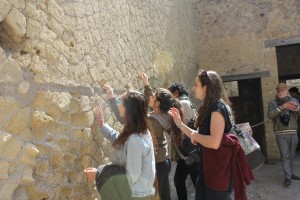
The Southern Field Trip was the last, the sunniest, and arguably the conclusive favorite of the Spring 2015 Cornell in Rome class. Consisting of five busy and exciting days of tours through sites in ancient Herculaneum, Napoli, Padula, Matera, and Trani, each city captured the imaginations and intellects of the group of aspiring designers, urbanists, and artists.
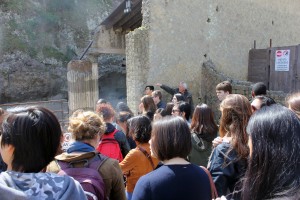
The trip began with a tour, led by Ancient Architectural History professor Jan Gadeyne, of the ancient civilization of Herculaneum. The primal street systems, bathhouses, and residential structures still rise from the surrounding ruins—an impressive homage to the brilliant engineering and construction techniques practiced hundreds of years ago.
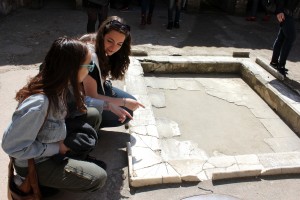
After a day in Herculaenum, we arrived in Napoli just after nightfall. Tired and hungry, it wasn’t long before groups of students poured back out into the glowing streets in search of dinner. Luckily, a shortage of good food is not Napoli’s problem. Indeed, Napoli is the famous birthplace of pizza. Thick, spongy, inexpensive, and ubiquitous at the corner of almost every street, a hearty round of Neapolitan pizza was the perfect end to a busy first day.
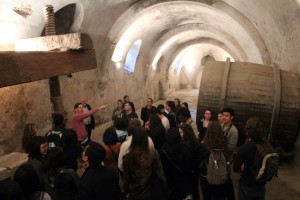
The next day, we arose early to begin a day of exploring the crowded and bustling streets of central Napoli led by the venerable Jeffrey Blanchard, professor of Renaissance and Baroque Architecture History as well as director of the Cornell in Rome program. Highlights of the walking tour included a visit to the Pio Monte della Misericordia that holds a famous altar painting by Caravaggio and a look around the breathtaking Cappella Sansevero with its uncannily beautiful sculpture of the Veiled Christ by Sanmartino. Professor Blanchard brought Caravaggio’s dramatic and emotional painting alive with his vivid description of Caravaggio’s equally turbulent and fraught life. From reports of violently flung trays of artichokes to murders committed over ballgames, Caravaggio was hardly the proper and dignified Renaissance man of his time. With less drama in life, but equal spectacle in art, Sanmartino’s Veiled Christ remains one of the most wondrous marble sculptures the world has ever seen. The depiction of skin through fabric is astounding and every detail shines outward, a hyper-real extension of an imagined experience.
Before lunch, the Architecture and Art majors switched gears to experience a bit of the contemporary Neapolitan art world. Located in an historical complex redesigned by famed architect Akvaro Siza, MADRE is the home to Napoli’s admired collection of contemporary art. Featuring work by Anish Kapoor, Joseph Bueys, and Richard Serra, the museum offered a glimpse back to the contemporary and a new, international context with which to view the historical monuments and artworks present throughout the rest of the city.
Our day in Napoli ended with a funicular ride to the Certosa di San Martino at the top of one of Napoli’s formidable hills. Surrounded by the tranquil grounds of the historical Charterhouse, the sun slowly melted behind Mount Vesuvius, washing the Bay of Naples in a sheer veil of golden light.
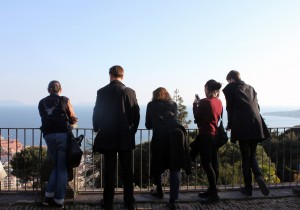
With a quick breakfast and an early start, the students of Architecture, Art, and Planning jumped back on the bus and were soon off to Padula and another beautiful example of Charterhouse and garden design at the Certosa di Padula. Charterhouses are run by an ancient religious order known as the Carthusians. Carthusians dedicate themselves to a life of silence and seclusion, defined by prayer and the pursuit of peaceful and practical activities such as gardening. The charterhouse at Padula is no longer inhabited, but charterhouses in other parts of Europe still function today. During our tour, we explored the great communal spaces and isolated chambers present throughout the uniquely programmed structure. The gardens were equally impressive, featuring a range of formal parterres, forested areas, and meadow-like spaces in addition to food gardens.
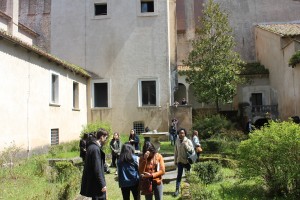
After another short bus ride, we arrived in Matera. Easily one of the favorite destinations Cornell in Rome has visited, Matera was unbelievably beautiful. Old Matera is constructed directly into the side of a mountain, with houses and shops excavated from existing caves. Split into smaller groups, we had the opportunity to stay in hotels renovated from these old structures, called Sassi. Still a hidden gem, Matera was refreshingly empty of tourists and retained the magical feel of a small, mountainous village.
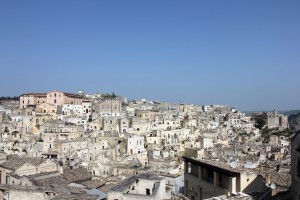
The following day, a local tour guide led us through the winding streets that laced the hillsides. The tour ended with a trip to MUSMA, a museum of contemporary sculpture built into the Sassi. Here, contemporary sculptural works stood out brilliantly against the narrow corridors and rough stonewalls of the renovated cave system. Each turn led to a new gallery cleverly tucked behind a boulder or hollowed beneath a rocky plateau. All were sad to leave the picturesque and breathtaking skyline of Matera that night, but boarded the bus inspired with new energy for the final leg of the fieldtrip.
After staying the night in the midway city, Bari, we departed for our final destinations: Castel del Monte and the small port town of Trani. Castel del Monte was built for Frederick II in the mid 1200’s. An impressively fortified structure, it represents one of the best examples of Italian castle designs. The nearby town of Trani also stood out as a favorite among the participants of the program. A somewhat sleepy town, it is nevertheless home to a significant cathedral built in the 11th – 14th centuries.
As we waved goodbye to the sea, the south, and another remarkable journey through the artistic, architectural, and urban histories of Italy, we prepared ourselves for the last weeks of studying and exploring our own eternal city of Rome.
